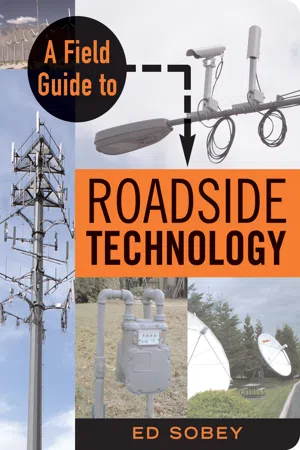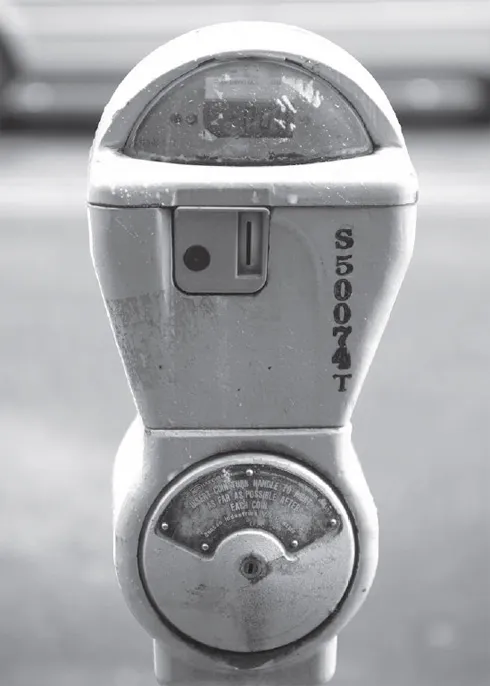![]()
1 HIGHWAYS AND ROADWAYS
HIGHWAYS AND ROADWAYS ARE technology showcases zipping past your car window as you travel along at 60 MPH (100 KM/H). Every few seconds you whiz by yet another piece of machinery. Luckily, the same type of device is often found at every intersection or every few miles, so you have many opportunities to see and identify each one.
Since state and local governments maintain their own roads and highways, many of the devices you see aren’t uniform across the country. Highway devices in California may not look exactly like similar devices in Massachusetts. However, if you can identify a machine in one location, you will have clues as to what a device of similar size and shape does in a different location, even if it isn’t exactly the same.
Traffic Signal
BEHAVIOR
Controls traffic by indicating which lane of cars should move through the intersection.
HABITAT
At busy intersections.
HOW IT WORKS
Watch a traffic signal and you’ll figure out that it uses a timer. The light stays green for maybe 30 seconds, turns yellow for 5 or so seconds, then turns red for perhaps 35 seconds while the green and yellow lights for the other lanes of traffic complete their cycles.
Traffic engineers set the times for each part of the cycle based on the traffic load on each street. They may also change the cycle to run faster at night when there are fewer cars on the road. Many traffic signals are also controlled by switches (see below).
UNIQUE CHARACTERISTICS
Does the red light look different from the yellow and green lights? Instead of using normal incandescent light bulbs (like the ones you use at home) for red lights, many cities now use LEDs, or light-emitting diodes. LEDs have a deeper color than incandescent bulbs. You can see the many sources of light, which are the individual diodes. It takes dozens of tiny LEDs to make up one red traffic light.
LEDs are much more expensive than regular lights. Why would traffic departments switch to a more expensive light? LEDs can last as long as 10 years—several times longer than traditional lights. The expense of sending a crew out to change a traffic light bulb is so great that it’s cheaper to use a more expensive light source that lasts longer. Lighting engineers just recently developed good yellow and green LEDs, and traffic departments are starting to install those colors now.
If you see a traffic signal that uses incandescent bulbs open for repair, look inside to see what color the bulbs are. They might not be red, green, and yellow. Some cities use a yellow bulb shining through a blue cover to make a green light.
Increasingly, engineers are installing additional devices called switches to control the lights as well. At an intersection, look for dark lines in the shape of a square or rectangle in the road’s surface. The dark lines are patched strips in the road where workers sawed up the original roadway to install an induction vehicle detector (see page 19), which consists of loops, or coils, of wire that detect cars and change traffic lights accordingly.
At some intersections you’ll see other devices that prompt traffic lights to change. These include video detection cameras (see page 20) and microwave vehicle detectors (see page 20), which are mounted on traffic poles.
Old traffic signals use mechanical systems to turn each light on and off. You can hear the motors and switches inside these signals working as the lights change.
Modern traffic signals use electronic circuits instead of mechanical systems to control the lights. The next time you’re stopped at one of these, look for the traffic signal control box (see page 18), which houses the signal’s timer, or clock, and switches. It may be mounted on one of the traffic-signal poles or placed on the ground behind the signal.
INTERESTING FACTS
Traffic lights were used even before automobiles were invented. Starting in 1868, the British used red and green lights to control horse carriage traffic at busy intersections. A police officer had to manually switch the lights from red to green and back. The use of a yellow light also originated in Great Britain, in 1918.
The first red and green traffic lights in America appeared in Cleveland, Ohio, in 1914. A police officer, William Potts, created the first three-color light used in the United States and had it installed in Detroit in 1920. Three years later the famous inventor Garrett Augustus Morgan invented the automatic traffic light.
Traffic Signal Control Box
BEHAVIOR
Houses electronic circuits and power supplies that control traffic lights.
HABITAT
At any intersection where you find a modern traffic signal you will find one or two control boxes, usually on one of the corners of the intersection. Often, as is the case shown here, you will see two boxes. One houses the electronic circuits and the other houses power supplies for the traffic signal.
HOW IT WORKS
One box (shown on the left in this photo) controls the signals. Inside it is a computer. The computer can be set to change the traffic lights at set time periods. For example, it may be set to cycle through the green, yellow, and red lights every 30 seconds. The timing can be set to change throughout the day to accommodate changes in traffic patterns. Traffic engineers study the flow of traffic and program a computer to run the lights accordingly.
If there is an induction vehicle detector (see page 19) at the intersection, its signals go into the control computer as well. As a car pulls up to the intersection and stops above the detector’s wire ground loop, the sensor (loop) sends a message to the computer, which prompts the traffic light to change.
The second box distributes power to the computer and the traffic signal. Electrical power comes into this box from electric wires located on utility poles or underground. Inside this box are the connections.
What color is the green light? Most incandescent light bulbs used in traffic signals emit white light. To get the red, yellow, and green colors you see, the light from the bulbs shines through colored glass covers. You might detect a bluish tint to green lights. Blue is incorporated in the green light’s cover to help people who are red-green colorblind see a difference between the stop and go lights.
Induction Vehicle Detector
BEHAVIOR
When a vehicle moves over the detector, the detector sends a message to the traffic signal’s computer to start the cycle to change the lights.
HABITAT
Busy intersections. Look on the ground for a thin bead of black asphalt that covers up the square or rectangle of wire that was installed after the road was last paved.
HOW IT WORKS
This operates in the same way as do the metal detectors you see people using at the beach or in a park. An electric current flows through the coil of wires under the street. As a car moves over the coil, the car’s metal changes the magnetic field in the coil. A sensor in the circuit of the coil detects the change in the magnetic field and sends a signal to the computer in the control box.
UNIQUE CHARACTERISTICS
Some cities mark the place in the road that covers the most sensitive area of the coil with an “X” so people riding bicycles know where to stop. Since bikes have much less metal than cars, the detector might not notice the change in the magnetic field caused by the bike unless it is placed directly over the most sensitive area of the coil. The mark shows where the bicyclists should stop to change the signal.
INTERESTING FACTS
The wire coils are set about two inches below th...




